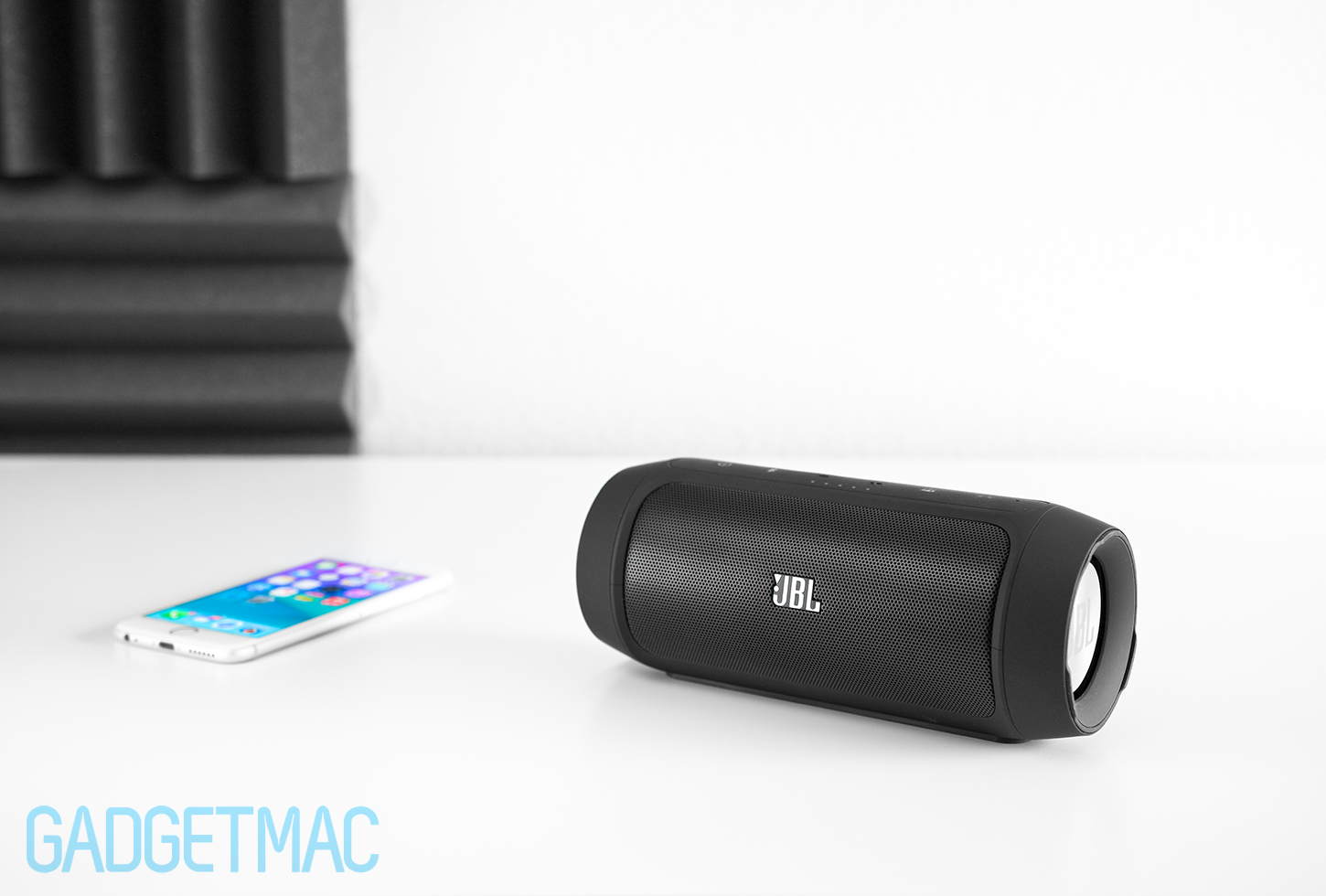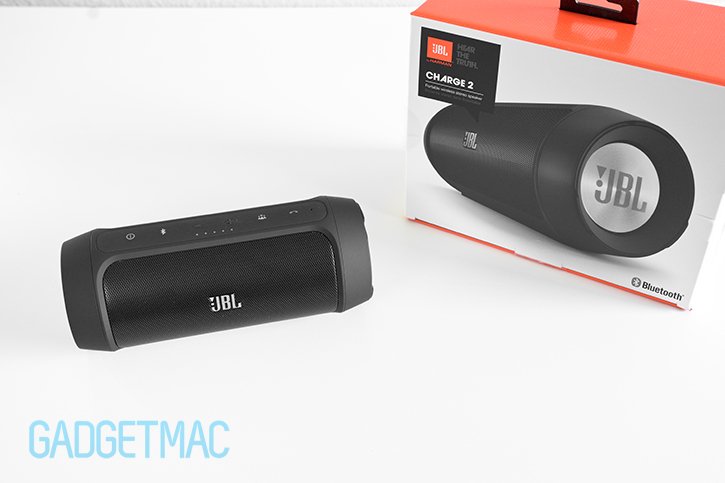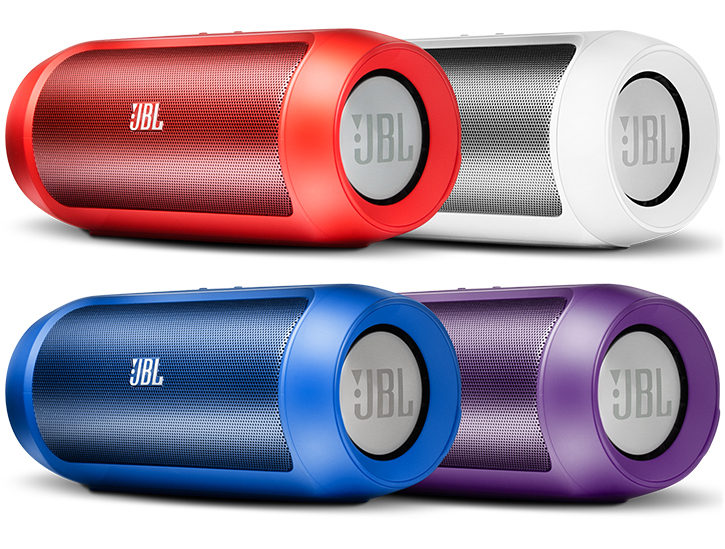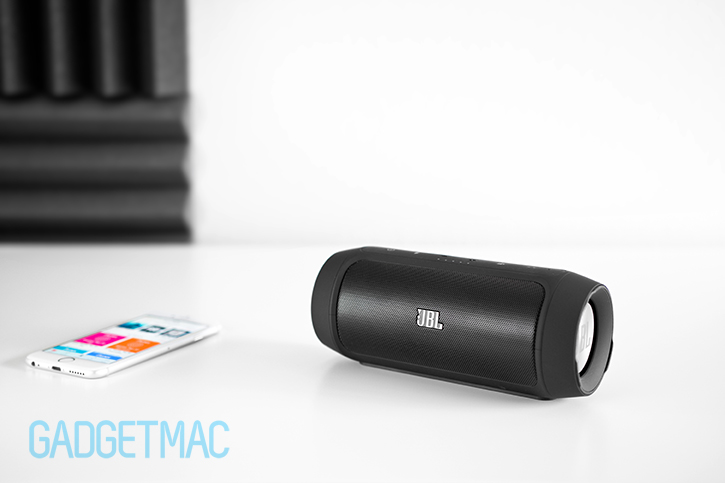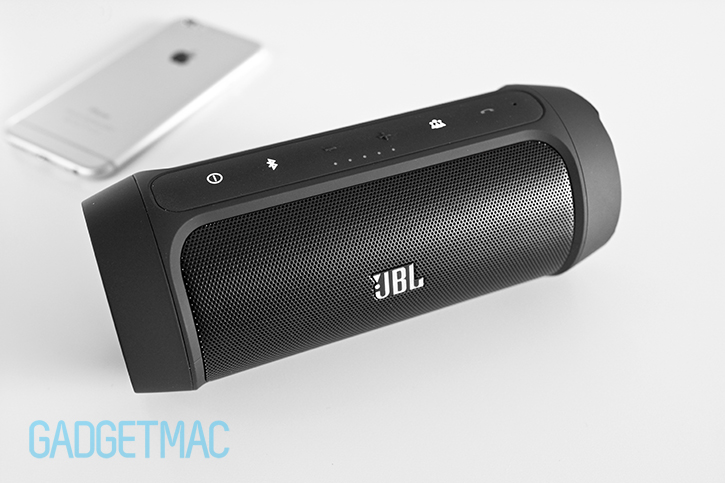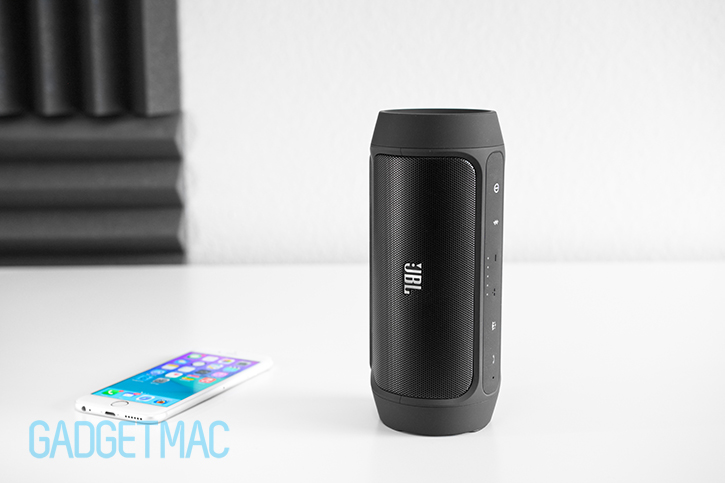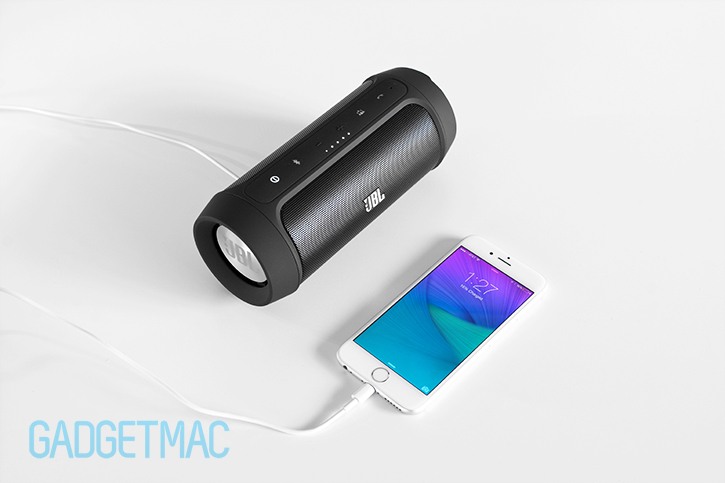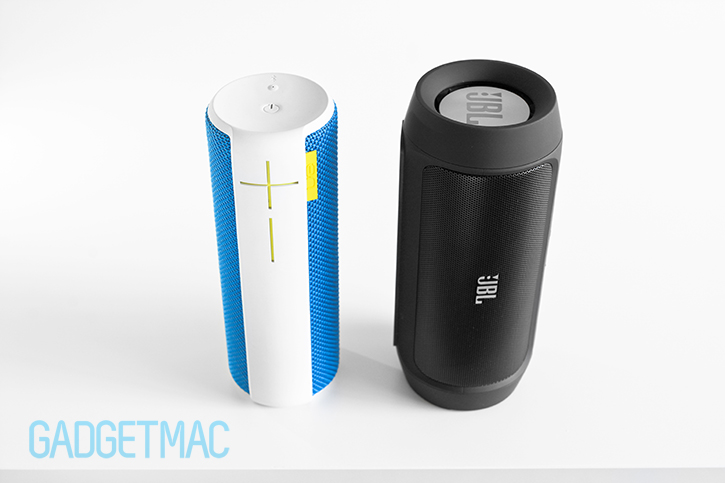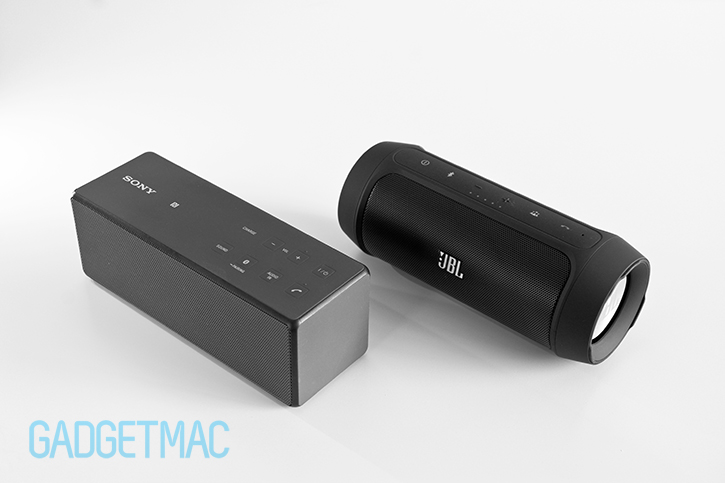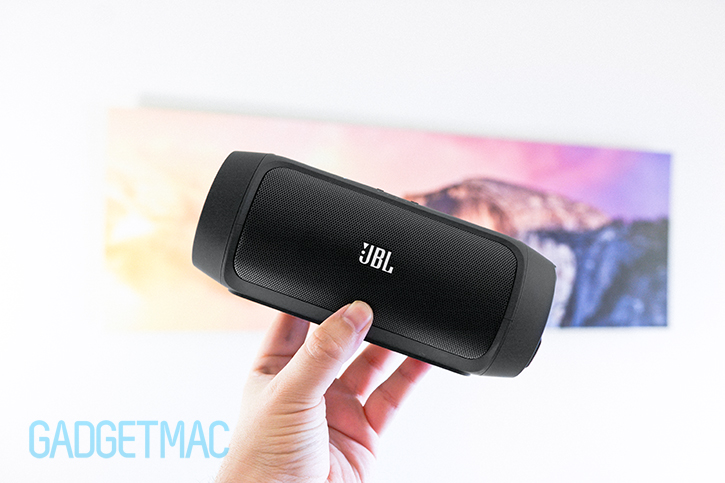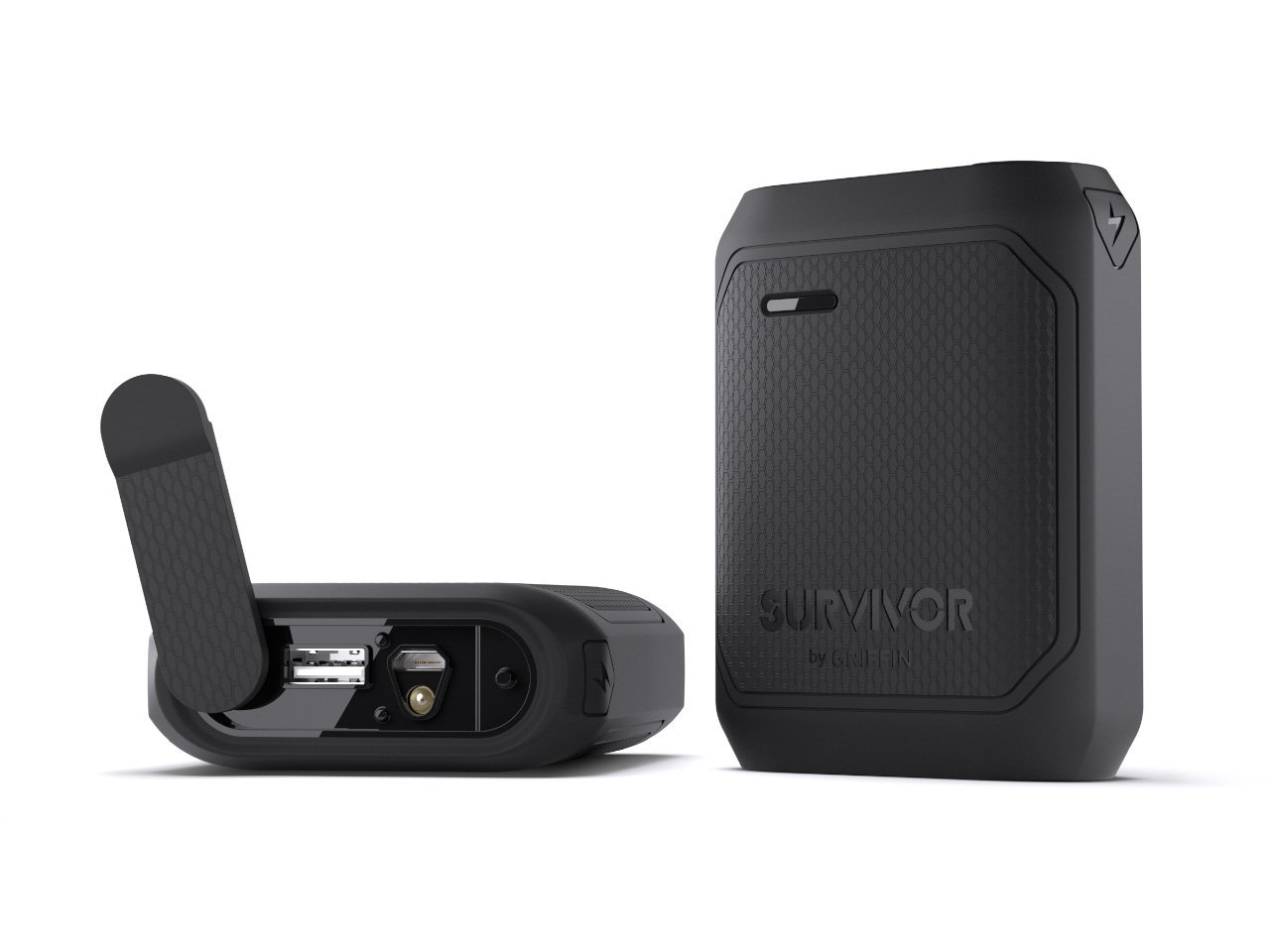JBL Charge 2 Portable Wireless Speaker Review
/JBL recently updated one of its most sought-after portable speakers with the second generation Charge 2 portable wireless Bluetooth speaker. If you thought the original award-winning Charge speaker sounded good, wait until you hear the Charge 2 in action. It has been outfitted with larger, better dual 45mm drivers and a pair of passive side-firing radiators for that much needed special delivery of bassy low-end goodness to liven up your music experience. With the addition of improved internal hardware, the Charge 2 has been redesigned to look sleeker than its predecessor with a more contemporary design along with a more polished build quality. JBL's Charge 2 still features the same useful added features like the ability to charge external portable devices while you're on the move, and make hands-free speakerphone calls thanks to a built-in microphone with noise and echo-cancelling technology. The Charge 2 sounds like a worthy successor, but is that enough to compete with today's leading portable Bluetooth speakers? Let's find out!
The Charge 2 comes well protected and nestled within favorable orangey packaging that's fairly easy to open. There's nothing too exciting about JBL packaging in general. They're all very utilitarian, and we still appreciate it just as much.
Inside the accessory compartment you will find a lengthy one meter-long micro-USB to USB charging cable, a compact USB wall adapter (much smaller than the one included with the original Charge), and a user guide. What isn't included this time around is a protective neoprene carrying sleeve.
You'll be able to pick one up in five attractively vibrant colorways including red, blue, purple, white and of course black. We're really happy to see that JBL did not raise the pricing of the Charge 2 considering it offers more bang for your buck compared to last year's model. The Charge 2 will run you $150, which to put into prospective, is what you'll also pay for one of our favorite wireless speakers this year – the Sony SRS-X3. Which also means that the Charge 2 is also $50 less than what you would pay for arguably the two most prominent portable speakers currently dominating the Bluetooth speaker market: the Ultimate Ears UE Boom and Bose SoundLink Mini.
As expected, JBL has perfected the Charge with the newly released Charge 2 successor. It's an impressively more fine tuned when it comes to audio performance and even a lot more refined by design, which we were really thrilled about having reviewed the original Charge speaker. And that's to be expected really. JBL has done a similar redesign of its original Flip portable speaker model with the introduction of the Flip 2, and now we've got the Charge 2 promising an increase in sound quality performance as well as having a more social-friendly functionality. We’re seeing similar design influences carried over from the Harman Kardon side of speaker design, namely the Nova desktop wireless Bluetooth speakers which feature the same bass radiator design language now present on the two side-firing passive bass radiators of the Charge 2. It looks fantastic and presentable in a premium-looking kind of way. It's a huge departure from the original Charge model, and we're really glad that JBL is starting to create higher-end designs at reasonable and familiar JBL prices.
Like its predecessor, the Charge 2 features the same 6,000mAh built-in rechargeable battery boasting up to an impressive 12 hours of wireless audio streaming while also enabling you to charge other portable devices like your smartphone using its dedicated backup USB charging port. And while not much has changed in terms of battery life, the Charge 2 has been redesigned and improved from the inside out offering a compelling upgrade over the original Charge model that JBL first introduced last year, which was really only JBL's Flip speaker repackaged with additional features like a massive rechargeable battery capacity and a mediocre bass port. The Charge 2 is without a doubt more sleeker looking than the original model, but it doesn't come with any durability improvements. It's still not waterproof, rain-resistant, or anything of the sort like other offerings, notably the hugely popular UE Boom by Ultimate Ears. Come to think of it JBL has yet to enter that type of durability specification when it comes to its portable wireless speakers, but something tells me it’s only a matter of time.
Apparently the reason behind these exposed bass radiators is because JBL wants you to see how they vibrate when playing bassy tracks. And I must say that I do enjoy the sight of driver-thrusting action. Who doesn't really. Of course your not supposed to touch the bass radiators when they're active as you can ruin them, but they are protected with a machined radial-finished aluminum woofer cone that adds extra layer of reliant protection during travel or the occasional touching from a curious friend.
And here is one of the two passive bass radiators trembling in action.
One of the things that immediately impressed me the most about JBL's Charge 2 when I first unwrapped it from its protective wrapping was its construction. The build is superb. Not in anyway as premiumly made as the SoundLink Mini for obvious reasons, but not remotely disappointing either. The construction of the Charge 2 is very solid, complete with a well implemented rubberized backlit control interface, and it uses what seems like high quality materials with thoughtfully finished plastic that has a very fine soft-touch coating applied to the surface.
Everything from the rubberized bottons and side-facing feet for versatile horizontal or upright usability, to the finely perforated front and back metal speaker grilles that gently wrap around the speaker giving the Charge 2 its unique JBL identity and durable quality feeling is fantastically done. You'll notice all of this first hand the moment you pick it out of the box. It's reminds me a lot of JBL's Pulse speaker in that it uses much of the same cylindrically-shaped rubberized plastic construction, yet it's much sturdier and refined in the way that it's put together. The design of the Charge 2 looks less robust and ruggedized than the original Charge, however, it isn't any less impressive.
If we take a look underneath the Charge 2 we can see that it has a single rubber foot much like the Pulse model that provides outstanding surface traction as well as eliminating any vibrations that cause unwanted movement of the speaker or rattle.
In addition to placing the Charge 2 horizontally on a table like most portable speakers, the Charge 2 can also be used vertically like the original Charge 2 when listening to music. By using the Charge 2 in this particular orientation you're not actually improving the way that you hear the audio being played. It's merely a novelty feature and just one more form of use that really doesn't bring any value to your listening experience. We would have much preferred a secondary angled orientation that would better orient the output of sound coming from the speaker depending on where you sit or stand near the speaker kind of like how the Flip 2 offers a slanted upright orientation as oppose to the straight vertical stance of the Charge 2.
But what JBL has done in order to prevent the speaker from blocking the bass output from the side-firing bass radiator when used in this orientation is to give the side edges three protruding rubberized feet that provide just enough room for the bass and air to be pushed through these gaps when set standing on a flat surface.
The original JBL Charge was made famous by its ability to charge other external devices and essentially serving as a portable backup battery charger even while users continued to wirelessly stream music via a compatible Bluetooth-enabled audio source. The same great winning formula is of course present in the Charge 2, and it's even better than its predecessor...which is to be expected out of seconded generation gadget. And by better we mean faster. Although still retains the same 6,000mAh battery on the inside, the Charge 2 has a 5V 2.1A built-in USB charging port that delivers a faster charge than its predecessor.
The Charge 2 can rapidly and fully charge your iPhone 6 without even breaking a sweat. On a full charge, the internal battery of the Charge 2 was capable of providing enough backup juice to charge an almost empty iPhone 6 all the way back up to 100%, and all the while its internal battery capacity has barely taken a hit with only 4 of the white LEDs remaining out of the five in total displayed on the battery gauge. We're really astounded by the Charge 2's battery capability to say the least. It's also important to note that it has only taken less than an hour and a half to fully charge the iPhone 6 using the Charge 2 speaker. If that doesn't amaze your inner geek, I don't know what will.
Around the back, the Charge 2 has got a micro-USB charging port, a regular 3.5mm audio input for optional wired audio source input connection (audio cable not included), and last but not least, the USB charging port where you can connect your own smartphone cable to charge it up. Of course this will also work with many tablets, and other portable devices like GoPro cameras.
Thankfully however, the Charge 2 can be charged using a micro-USB cable and even includes an optional USB wall adapter should you want to charge it quicker using a faster 2.3A of USB output power. I definitely recommend that you do use the included wall adapter since it does take a bit of time to fully charge this beast and its huge 6,000mAh internal battery capacity. It takes about 4 hours to fully charge, which is understandable given the size of the battery which of course is designed to double as a backup battery bank for sharing with external gadgets such as your smartphone when you're on the go and have no access to a power outlet.
Like its predecessor, the Charge 2 also features a speakerphone with a built-in noise and echo-cancelling microphone as well as a answer/end call button positioned on the speaker itself. When we tried using the Charge 2 to make a call, it wouldn’t respond. When we received a call, we could barely hear the caller even when setting the volume on full. I’m not sure what the issue is, but our Charge 2 simply failed at working as it should when we tried to make or receive a call with an iPhone 6 Plus paired with the speaker. Something tells me that the Charge 2 is not compatible with Apple’s latest iPhone 6 and iPhone 6 Plus models when it comes to using it as a hands-free speakerphone over Bluetooth. And when we did try a different Android smartphone, the Charge 2’s speakerphone feature started working faultlessly. We really hope that JBL addresses this incompatibility issue with Apple’s latest smartphones using a software update of some sorts.
At the top of the speaker we can see a number of on-board button controls that are seamlessly integrated into a layer or rubber. From left to right we have power on/off, Bluetooth pairing, volume down and up, Social mode (a multi-user Bluetooth pairing feature), call answer/end button that doubles as a play/pause/skip function and a microphone right next to it. The buttons are all very easy to press through the rubber similar to JBL's Pulse and Flip 2 speakers, and are actually backlit with white LED lights that light up when a certain feature is active. It's a nice change from the red and blue colored LEDs of the original Charge model. Oddly enough, the two volume up and down buttons are the only ones that aren't backlit and are hard to see on the black colored model.
We're very happy to see that JBL has closed the design and feature gap between its portable wireless speakers with the Charge 2 by adding useful features like a battery indicator gauge complete with 5 white LEDs that tell you how much battery is remaining in addition to showing you the charging status of the internal rechargeable battery. Unlike the Pulse and Flip 2 models, the Charge 2 has that LED battery gauge displayed on the front right underneath the on-board button controls where it serves it purpose amazingly well.
Like its predecessor, the Charge 2 also features a speakerphone mode with a built-in noise and echo-cancelling microphone as well as a dedicated answer/end call button on the speaker itself that blinks when you receive a call and turns solid during the conversation. When we tried using the Charge 2 to make a call using the iPhone 6 Plus, it wouldn’t respond. When we received a call, we could barely hear the caller even when setting the volume on full and the answer/end call button would not respond at all. I’m not sure what the issue is exactly, but our Charge 2 review unit (brand new mind you) simply failed at working correctly when we tried to make or receive a call with an iPhone 6 Plus paired with the speaker. Something tells me that the Charge 2 is quite simply not compatible with Apple’s latest iPhone 6 and iPhone 6 Plus models when it comes to using it as a hands-free speakerphone over Bluetooth. And when we did try a different Android smartphone, the Charge 2’s speakerphone feature miraculously started working faultlessly. It also should work just fine with older iPhone models like the iPhone 5 and iPhone 5s. We really hope that JBL addresses this incompatibility issue with Apple’s latest smartphones using a software update, pronto.
Update: We have since updated our iPhone 6 and 6 Plus to the latest iOS 8.1 update which seemed to have completely fixed the issues we were experiencing with using the Charge 2's speakerphone functionality over Bluetooth. So it was Apple's fault all along. Now we can get back to talking to our portable wireless speaker instead.
Another feature that's new and exclusive to the Charge 2 is Social mode. As the name implies, Social mode essentially lets multiple audio source pair to the Charge 2 wirelessly over Bluetooth for when you've got company over or just using the Charge 2 as your designated party speaker so that multiple people can take turns in streaming their own music choices. All this is done without needing to use an app. It actually works flawlessly and with minimal audio cutout when switching between different audio source connections. Though I would have loved to see a smooth audio fade or mixture transition feature between music sharing instead that would more appeal to the amateur DJ in me.
With Social Bluetooth streaming enabled with the press of a button, up to three users can respectively take turns in playing music from their own personal library on their smartphone or tablet without the explicit permission of the hosting party. If you're the one throwing the party, this mode will save you from the inevitable stream of annoying requests from your guests to play something else. It's worth noting that other portable wireless speakers can also achieve this multi-pair audio streaming functionality over Bluetooth such as the UE Boom, but none of them actually have a dedicated button and name for that feature like the Charge 2. Not that it makes much difference in practice. However, the UE Boom can only be paired to two different devices at a time compared to the three devices that the Charge 2 can simultaneously be paired with to play music.
The Charge 2 is using Bluetooth 3.0, while not the latest version, I must say that the performance has been overall and unsurprisingly as solid as it gets. Even though the Charge 2 isn't compatible with the iPhone 6 and 6 Plus when it comes down to using it as a speakerphone, everything else is fully supported when paired over Bluetooth. The multi-use play/pause/skip button not only controls the iPhone's music, but it can also be used to control Siri. Or if you're using an Android device, you can replicate the same functionality on your device as well including taking control of Google Now.
The first thing that you'll notice right away when listening to the Charge 2 for the first time is the increased presence of bass. Without comparing it to other speakers, the Charge 2 pulls through with punchy bass and the same extraordinary clarity. It goes without saying that the Charge 2 sounds much richer and fuller than the original Charge including JBL's Flip 2 with the addition of the dual passive bass radiators on either side, yet it still retains that clear high-end that JBL is known for.
While the bass does faintly break apart at the highest volume and at times does introduce minimal distortion at full volume, it's still punchy. We haven't come across any portable speakers of this size that have performed any better at full volume including the more expensive SoundLink Mini from Bose. With that said, I'm quite impressed by the bass performance of the Charge 2. Although it won't blow you away, the bass is rich and nicely tuned with a polished kick and an acceptably deep low-end. Bass aside, the midrange does lack some detail and isn't as pronounced the highs and lows. Highs, vocals sound great and almost realistic as expected coming from the original Charge with plenty of brightness.
The UE Boom has been a perennial favorite of ours for quite some time now and has always been the portable speaker to best. Well, we have put it up against the Charge 2 and found that it had impressively outperformed the thinner sounding bass of the UE Boom. But that's about it. The Charge 2 is still no match for the UE Boom when it comes to clarity, detail and immersive soundstage. It also doesn't get as loud as the UE Boom with about 20% less volume output. Not only that but the Charge 2 is noticeably bulkier around the waist and lacks the sleek and ever so sexy, symmetrical form factor of the UE Boom. That said, the Charge 2's clean and clear highs are still very impressive even when compared to the UE Boom. Personally I think that with its superior bass performance, the Charge 2 does offer a more pleasing and fuller overall listening experience, which acceptably necessitates its thicker form factor.
Although the Charge 2 does deliver noticeably better sounding bass, the UE Boom has the upper advantage in audio immersion thanks to its 360-degree sound output versus the directional sound output of the Charge 2. We prefer the UE Boom's immersive and all-encompassing audio, but the lack of deep bass is definitely its biggest downside. I think that the Charge 2 could have been so much better if only it had the same 360-degree sound dispersion like the UE Boom. But Harman (the company that owns JBL, AKG, Harman Kardon, Infinity and other audio brands) decided in partnership with Linkin Park that it would rather create the more premium and higher-end Infinity One portable Bluetooth speaker instead.
The Infinity One is a $300 Charge 2-equivalent on steroids. It has more drivers inside (four 45mm drivers instead of two facing the front and back, and two passive bass radiators) so it's sounds a lot better than the JBL Charge 2, and it also features a more durable ceramic-coated all-aluminum construction that like the UE Boom, is also sand and water-resistant. And like the Charge 2, the Infinity One also has a 6,000mAh rechargeable battery inside that doubles as a backup battery bank capable of fully charging your smartphone in the blink of an eye using its 5V 2.1A USB charging port. Granted the Infinity One is wider than the Charge 2 at 10-inches compared to the 7.2-inch long form factor of the Charge 2, but both do charge the same familiar cylindrical shape with recessed side-firing bass radiators.
Pitting the Charge 2 up against the UE Boom was a clear fight with an expected outcome, but what we never would have thought is for the Charge 2 to arguably sound better than the Sony SRS-X3. And again, like the UE Boom, the SRS-X3 is a little louder than the Charge 2 but significantly loses its deep bass response at higher volumes. While the SRS-X3 delivers more defined mids, accurate lows (only at moderate volume levels) and a somewhat balanced sound signature in comparison, the Charge 2 delivers a warmer sound signature and most importantly, it doesn't lose its bass punchyness nearly as much as the SRS-X3 at higher volumes – which we think is the selling point that will appeal to more listeners. The biggest problem that the SRS-X3 has is that it can't get loud enough for me to enjoy without losing its bass response, whereas the Charge 2 doesn't have any trouble fulfilling my thirst for rich and enjoyable audio quality at room-filling audio levels.
When comparing the two side by side, we found that after listening to a wide variety of music genres, the Charge 2’s lows, mids and highs aren’t quite as clearly defined nor are they as vibrantly clear as they are on the SRS-X3. Also, vocals sound slightly clearer and upfront coming out of the SRS-X3 thanks to Sony's ClearAudio+ technology. That being said, if you’re not an audiophile or someone who does appreciate the smaller qualities in audio quality, then you’ll still thoroughly enjoy listening to the Charge 2's warmer sounding audio quality. When it comes to which speaker performs better, the SRS-X3 sounds finer at medium volumes whereas the Charge 2 takes the upper advantage in retaining its bass response at higher volumes leaving the SRS-X3 behind in terms of audio richness. It's also worth noting that the SRS-X3 has better low-end bass response with a heavier frequency drag that performs similarly to much larger speakers in comparison. But unlike the Charge 2, the SRS-3 comes with more trade offs like the fact that it cannot charge as quickly, doesn't have much bass presence at higher volumes, the volume cuts in half when it's low on juice and last but not least, it doesn't have the same great battery life as the Charge 2 (up to 12 hours vs. up to 7 hours – nor can it charge external portable gadgets.
If you like your bass and you're always low on juice when you're out and about, then you'll be thrilled to hear that we like the deeper and rounder bass performance of the Charge 2 the most out of the UE Boom as well as the SRS-X3. Granted the Bose SoundLink Mini does have the upper edge when it comes to lows, but like the UE Boom, it costs as much as $200, doesn't have a very long battery life and it cannot be charged using the standard and universally used micro-USB charging.
The Charge 2 is a monumental upgrade over its predecessor – notably a perennial favorite amongst portable Bluetooth speaker enthusiasts. JBL’s Charge 2 is without a doubt one of the best performing portable speakers that JBL has ever made. It's a lot more refined than the original Charge in its design, and although not much has really changed, the Charge 2 is all about that bass enhancement. In fact, you’ll be hard pressed to find a superior alternative to the Charge 2 if you’re looking for a similar portable speaker at this price range. We would tell you to go with Sony's crisp-sounding $150 SRS-X3, but because it simply has far too many drawbacks in comparison, the Charge 2 will ultimately be the better choice for most people. Unless you've read our review and you're willing to accept the SRS-X3's flaws, the Charge 2 is still a fantastic option and a bold portable performer.
The new 'Social Mode' pairing feature that let's up to three users take turns playing their own music collection using their personal devices is unique to the Charge 2. And while it works flawlessly and as advertised, we don't see it really being a selling point or a must have feature over the original Charge. The biggest and most compelling difference between the Charge 2 and its predecessor is still audio quality. Currently the Charge 2 beats every portable Bluetooth speaker in JBL's lineup including the flashy and attractively colorful Pulse, the affordably priced Flip 2, and the palm-sized Clip.
If you are looking to get a portable speaker to simultaneously serve your music listening and backup charging needs, look no further than the Charge 2. With its very useful and super quick gadget charging functionality, great battery life, solid build quality (albeit lacking water-resistant durability) and rich bassy sound quality – the Charge 2 is worth the price of admission at $150. But how convenient exactly is having to carry a speaker and one of your charging cables in case you need to recharge your smartphone along the way will have to be left for you to decide. The fact that the Charge 2 offers such an option is a valued benefit nonetheless. Then again you can always use one of these always-on-the-ready keychain charging cables instead. If you already own and love using your now old Charge speaker, we think that the new and improved Charge 2 is a compelling upgrade that is worthy of our high recommendation. We like it a lot, and still, we can't take our eyes off of the seemingly superior Charge 2 family member turned rival – the Infinity One.






